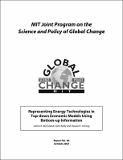| dc.description.abstract | This paper uses bottom-up engineering information as a basis for modeling new technologies within the MIT Emissions Prediction and Policy Analysis (EPPA) model, a computable general equilibrium model of the world economy. Natural gas combined cycle (NGCC) without carbon capture and sequestration (CCS), natural gas combined cycle with CCS, and integrated coal gasification with CCS power generation technologies are introduced into the EPPA model. These compete in the electricity sector with conventional fos sil generation, nuclear, hydro, wind, and biomass power generation. Engineering cost data are used together with EPPA data, including the underlying Social Accounting Matrix (SAM) and supplementary physical energy accounts, to assure that technologies, w h en simulated within the model, meet thermodynamic efficiency limits, and that they reflect regional differences in the cost structure of the electric sector. Alternative capital vintaging approaches are investigated and an explicit treatment of market p enetration of new technologies is developed. Simulations through 2100 show the introduction of the new technologies and their decline as fuel and input prices, and carbon policies, change. A general result is that NGCC plants with or without capture, wh il e currently less costly methods of abating carbon emissions from the electric sector based on engineering data, play only a limited and short-term role in meeting carbon limits. By 2050 the coal CCS plants, currently the most costly of the three techno logies, dominate in the simulated policy scenarios because rising gas prices raise the cost of the gas-based technologies. | en_US |
